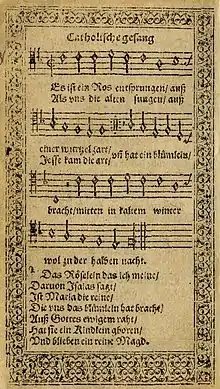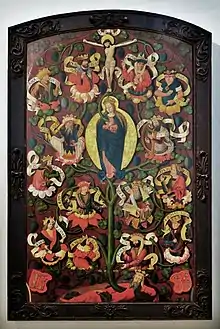| "Es ist ein Ros entsprungen" | |
|---|---|
| German Christmas hymn by Anonymous | |
 First printed in the 1599 Speyer Hymnal | |
| Genre | Hymn |
| Occasion | Christmas |
| Text | Unknown author |
| Language | German |
"Es ist ein Ros entsprungen" (literally "A rose has sprung up") is a Christmas carol and Marian hymn of German origin. It is most commonly translated into English as "Lo, how a rose e'er blooming" and is also called "A Spotless Rose" and "Behold a Rose of Judah". The rose in the German text is a symbolic reference to the Virgin Mary. The hymn makes reference to the Old Testament prophecies of Isaiah, which in Christian interpretation foretell the Incarnation of Christ, and to the Tree of Jesse, a traditional symbol of the lineage of Jesus. Because of its prophetic theme, the hymn is popular during the Christian season of Advent.[1]
The hymn has its roots in an unknown author before the 17th century. It first appeared in print in 1599 and has since been published with a varying number of verses and in several translations. It is most commonly sung to a melody harmonized by the German composer Michael Praetorius in 1609.[1] The hymn's popularity endures in the 20th and 21st centuries.[2]
Meaning

The hymn was originally written with two verses that describe the fulfilment of the prophecy of Isaiah foretelling the birth of Jesus. It emphasizes the royal genealogy of Jesus and Christian messianic prophecies.[1] The hymn describes a rose sprouting from the stem of the Tree of Jesse, a symbolic device that depicts the descent of Jesus from Jesse of Bethlehem, the father of King David.[3] The image was especially popular in medieval times, and it features in many works of religious art from the period. It has its origin in the Book of Isaiah:[1]
And there shall come forth a rod out of the stem of Jesse, and a Branch shall grow out of his roots.
The second verse of the hymn, written in the first person, then explains to the listener the meaning of this symbolism: That Mary, the mother of Jesus, is the rose that has sprung up to bring forth the Christ child, represented as a small flower ("das Blümlein"). The German text affirms that Mary is a "pure maiden" ("die reine Magd"), emphasizing the doctrine of the Virgin birth of Jesus. In Theodore Baker's 1894 English translation, on the other hand, the second verse indicates that the rose symbolizes the infant Christ.[4]
Since the 19th century, other verses have been added, both in German and in translation.
History
The poetry of Isaiah's prophecy has featured in Christian hymns since at least the 8th century, when Cosmas the Melodist wrote a hymn about the Virgin Mary flowering from the Root of Jesse, "Ραβδος εκ της ριζης", translated in 1862 by John Mason Neale as "Rod of the Root of Jesse".[5][6]
The text of "Es ist ein Ros entsprungen" dates from the 15th century. Its author is unknown. Its earliest source is in a manuscript from the Carthusian Monastery of St Alban, in Trier, Germany, that is now preserved in the Trier City Library and is thought to have been in use at the time of Martin Luther. The hymn first appeared in print in the late 16th century in the Speyer Hymnbook (1599).[6] The hymn has been used by both Catholics and Protestants, with the focus of the song being Mary or Jesus, respectively.[7] In addition, there have been numerous versions of the hymn, with varying texts and lengths. In 1844, the German hymnologist Friedrich Layriz added three more stanzas,[8][9] the first of which, "Das Blümelein so kleine", remained popular and has been included in Catholic[10] and Protestant hymnals.[11]
The tune generally used for the hymn originally appeared in the Speyer Hymnal (printed in Cologne in 1599), and the familiar harmonization was written by German composer Michael Praetorius in 1609.[7] A canon version for four voices also exists, based on Praetorius's harmony and sometimes attributed to his contemporary, Melchior Vulpius.[12] The metre of the hymn is 76.76.676.
In 1896, Johannes Brahms used the hymn's tune as the base for a chorale prelude for organ, one of his Eleven Chorale Preludes Op. 122, later transcribed for orchestra by Erich Leinsdorf.[13][14][15]
During the Nazi era, many German Christmas carols were rewritten to promote National Socialist ideology and to excise references to the Jewish origins of Jesus. During Christmas in Nazi Germany, "Es ist ein Ros entsprungen" was rewritten as "Uns ist ein Licht erstanden/in einer dunklen Winternacht" ("A light has arisen for us/on a dark winter night"), with a secularised text evoking sunlight falling on the Fatherland and extolling the virtues of motherhood.[16]
The hymn's melody has been used by a number of composers, including Hugo Distler who used it as the base for his 1933 oratorio Die Weihnachtsgeschichte (The Christmas Story).[1] Arnold Schoenberg's Weihnachtsmusik (1921) for two violins, cello, piano and harmonium is a short fantasy on Es ist ein Ros entsprungen with Stille Nacht as a contrapuntal melody.[17] In 1990, Jan Sandström wrote Es ist ein Ros entsprungen for two a cappella choirs, which incorporates the setting of Praetorius in choir one.
English translations
Well-known versions of the hymn have been published in various English translations. Theodore Baker's "Lo, How a Rose E'er Blooming" was written in 1894[4] and appears in the Psalter Hymnal (Christian Reformed Church in North America) and The United Methodist Hymnal (American United Methodist Church).[18][19]
The British hymn translator Catherine Winkworth translated the first two verses of the hymn as "A Spotless Rose".[20] In 1919 the British composer Herbert Howells set this text as a motet for SATB choir.[7] Howells stated that:
I sat down and wrote A Spotless Rose...after idly watching some shunting from the window of a cottage in Gloucester which overlooked the Midland Railway. In an upstairs room I looked out on iron railings and the main Bristol to Gloucester railway line, with shunting trucks bumping and banging. I wrote it and dedicated to my mother – it always moves me when I hear it, just as if it were written by someone else.[21]
Howells' carol is through-composed, switching between 7/8, 5/4 and 5/8 time signatures, unconventional for a carol of this era.[22] The plangent final cadence ("On a cold, cold winter's night"), with its multiple suspensions is particularly celebrated.[22] Howells' contemporary, Patrick Hadley reportedly told the composer "I should like, when my time comes, to pass away with that magical cadence".[23] Winkworth's translation was again set to music in 2002 by the British composer and academic Sir Philip Ledger.[24]
A further English translation of the hymn, "Behold, a rose is growing", was written by the American Lutheran musician and writer, Harriet Reynolds Krauth Spaeth (1845–1925). Her four-verse version is often published with an additional 5th verse, translated by the American theologian John Caspar Mattes (1876–1948).[25][26]
Another Christmas hymn, "A Great and Mighty Wonder", is set to the same tune as this carol and may sometimes be confused with it. It is, however, a hymn by St. Germanus, (Μέγα καὶ παράδοξον θαῦμα), translated from Greek to English by John M. Neale in 1862. Versions of the German lyrics have been mixed with Neale's translation of a Greek hymn in subsequent versions such as Percy Dearmer's version in the 1931 Songs of Praise collection and Carols for Choirs (1961).[27]
Lyrics
| German original | Baker's version | Winkworth's version[20] | Spaeth's translation with Mattes' 5th verse |
|---|---|---|---|
Es ist ein Ros entsprungen,[lower-alpha 1] |
Lo, how a rose e'er blooming, |
A Spotless Rose is blowing, |
Behold, a Branch is growing |
Das Röslein, das ich meine,[lower-alpha 1] |
The Rose which I am singing, |
Isaiah hath foretold it | |
The shepherds heard the story, | |||
Das Blümelein, so kleine,[lower-alpha 2] | O Flower, whose fragrance tender | This Flow'r whose fragrance tender | |
Lob, Ehr sei Gott dem Vater,[lower-alpha 2] |
|||
O Jesu, bis zum Scheiden[lower-alpha 2] | O Saviour, Child of Mary, |
Music

See also
References
- 1 2 3 4 5 Liebergen, Patrick M. (2005). Singer's Library of Song: A Vocal Anthology of Masterworks and Folk Songs From the Medieval Era Through the Twentieth Century : Book Medium. Alfred Music Publishing. ISBN 9780739036600. Retrieved 25 November 2017.
- ↑ Meyer, Robinson (25 December 2015). "'Lo, How a Rose E'er Blooming' Is a Musician's Christmas Carol". The Atlantic.
- ↑ Pfatteicher, Philip H. (2013). "2. Advent". Journey into the Heart of God: Living the Liturgical Year. Oxford University Press. ISBN 9780199997145. Retrieved 29 November 2017.
- 1 2 Leeman, David; Leeman, Barbara (6 October 2020). Hosanna in Excelsis: Hymns and Devotions for the Christmas Season. Moody Publishers. ISBN 9780802498854 – via Google Books.
- ↑ John Mason Neale. Hymns of the Eastern Church. Christian Classic Ethereal Library. p. 77. CiteSeerX 10.1.1.693.1215.
- 1 2 Roth, Nancy (2001). "Hymn 81: Lo How a Rose e'er blooming". Praise, My Soul: Meditating on Hymns. Church Publishing, Inc. p. 11. ISBN 9780898693744. Retrieved 29 November 2017.
- 1 2 3 "Lo How A Rose Eer Blooming – Notes". hymnsandcarolsofchristmas.com. Retrieved 18 December 2016.
- ↑ Herbst, Wolfgang (2001). Wer ist wer im Gesangbuch? (in German). Vandenhoeck & Ruprecht. p. 193. ISBN 978-3-525-50323-2. Retrieved 17 December 2020.
- ↑ Publishing, Alojado. "Lied Es ist ein Ros' entsprungen". lieder-archiv.de (in German). Retrieved 17 December 2020.
- ↑ "Gotteslob Online". gotteslob.katholisch.de. Retrieved 18 December 2016.
- ↑ Evangelisches Gesangbuch, no. 30, and Gesangbuch der Evangelisch-reformierten Kirchen der deutschsprachigen Schweiz (Swiss Reformed Church hymnal), no. 399
- ↑ "Stile Antico" (PDF). The Friends of Chamber Music. the friends of chamber music endowment early music series. Retrieved 25 November 2017.
- ↑ 11 Chorale Preludes, Op. 122 (Brahms): Scores at the International Music Score Library Project
- ↑ Owen, Barbara (2007). The Organ Music of Johannes Brahms. Oxford University Press, USA. p. 104. ISBN 9780195311075. Retrieved 25 November 2017.
- ↑ Bloom, Julius (1946). The Year in American Music: 1946–1947. Allen, Towne & Heath. p. 497. Retrieved 25 November 2017.
- ↑ Schwind, Elisabeth (23 December 2016). "Lieb aus deinem göttlichen Mund". Südkurier (in German). Retrieved 29 November 2017.
- ↑ MacDonald, Malcolm (2008). Schoenberg. Oxford University Press. p. 266. ISBN 9780198038405. Retrieved 25 November 2017.
- ↑ "Psalter Hymnal (Gray) 351. Lo, how a rose e'er blooming". hymnary.org. Retrieved 18 December 2016.
- ↑ ""Es ist ein Ros entsprungen" – A German Christmas Carol in German and English". www.german-way.com. Retrieved 18 December 2020.
- 1 2 Winkworth, Catherine (1869). Christian Singers of Germany. Macmillan. p. 85. ISBN 978-0-598-64823-5. Retrieved 18 December 2020.
- ↑ Palmer, Christopher (1978). Herbert Howells: a study. p. 16.
- 1 2 Phillip Cooke. "On Herbert Howells's 'A Spotless Rose'..." phillipcooke.com. Retrieved 12 December 2020.
- ↑ Spicer, Paul (1998). Herbert Howells. p. 67.
- ↑ "Sir Philip Ledger". sirphilipledger.com. Archived from the original on 14 April 2011. Retrieved 18 December 2016.
- ↑ "Behold, a Branch is Growing". Hymnary.org. Retrieved 28 December 2020.
- ↑ Evangelical Lutheran Hymnary. Morning Star Music Publishers/Evangelical Lutheran Church/Evangelical Lutheran Synod Worship Committee. May 1996. p. 121. ISBN 978-0-944529-18-8.
- ↑ "A Great and Mighty Wonder". Archived from the original on 25 April 2012. Retrieved 2011-12-09.
- ↑ "A. Es ist ein Ros entsprungen (Ältester Druck Speyer 1599)", Historisch-Kritisches Liederlexikon
External links
 Media related to Es ist ein Ros entsprungen at Wikimedia Commons
Media related to Es ist ein Ros entsprungen at Wikimedia Commons- List of all verses in German, from The Hymns and Carols of Christmas
- Free sheet music of "Lo, How a Rose E'er Blooming" for SATB, Cantorion.org
- "Es ist ein Ros entsprungen" (Praetorius): Scores at the International Music Score Library Project
- "Es ist ein Ros entsprungen" (Vulpius): Scores at the International Music Score Library Project
- MP3 of Sissel Kyrkjebø singing at a 2005 Christmas concert in Moscow, Internet Archive
